Wondering what the best roof coating for shingles is? The best choice depends on your roof’s needs and your local climate. We’ll guide you through the top coatings like acrylic, silicone, polyurethane, and elastomeric, and explain their benefits to help you make the right choice.

Key Takeaways
- Roof coatings enhance shingle lifespan by acting as protective barriers against weather elements and can improve energy efficiency.
- Different types of roof coatings, including acrylic, silicone, polyurethane, and elastomeric, offer unique benefits based on climate and performance needs.
- Selecting the right roof coating involves considering factors such as material compatibility, climate suitability, durability, energy efficiency, and cost.
Why Roof Coatings Matter for Shingles
Roof coatings play a crucial role in maintaining and protecting roofs by:
- Shielding against wind, rain, and snow, extending the roof’s lifespan, and postponing expensive replacements.
- Acting as a waterproof barrier, it prevents water damage.
- Inhibiting mold, mildew, and moss growth on shingles.
- Rejuvenating older shingles by sealing leaks and enhancing overall performance, thereby avoiding premature roof replacement.
One of the most compelling benefits of roof coatings is their energy efficiency. An energy-efficient roof coating reflects sunlight and reduces heat absorption, which leads to overall lower cooling costs. Additionally, they can enhance the curb appeal of shingles by being tinted or pigmented to match your aesthetic preferences.
Investing in the right roof coating can significantly enhance the durability, performance, and appearance of your asphalt shingle roof.
Types of Roof Coatings for Shingles

Shingle roof coatings vary to meet different needs, climates, and conditions. The most common coating types — acrylic, silicone, polyurethane, elastomeric — each offer unique benefits.
Knowing these options helps in choosing the coating that offers optimal protection and performance for your asphalt shingle roof.
Acrylic Roof Coatings
Acrylic roof coatings, known for their durability and lifespan of over 10 years, offer excellent UV protection, making them ideal for sunny and hot climates.
Acrylic coatings are also suitable for sloped roofs in moderate to harsh weather conditions, helping to keep shingles in good shape.
Silicone Roof Coatings
Silicone roof coatings excel in rainy or humid climates, offering superior resistance to weathering and extreme temperatures, even on wet roofs. They also resist UV rays, helping to keep surfaces cooler and reducing heat absorption. Silicone coatings provide an additional layer of protection for your roof.
However, they can become slippery when wet and might not adhere as well as other material options.
Polyurethane Roof Coatings
Polyurethane coatings, known for their strong impact resistance and protective properties, are suitable for high-traffic areas like commercial or industrial buildings. They come in two types: aromatic, which is thinner and offers less UV protection, and aliphatic, which is thicker and more effective.
However, they are generally less UV-resistant than other coatings.
Elastomeric Roof Coatings
Elastomeric roof coatings form a durable, waterproof, and reflective membrane once cured. Their benefits include:
- High flexibility that prevents damage from cracking and peeling
- Excellent weather resistance
- UV protection
- Leak prevention
These features make them specifically designed for various roof types and climates.
Key Considerations for Choosing the Right Roof Coating

Choosing the right roof coating protects existing shingles from weather damage, enhances energy efficiency, and prolongs the roof’s shingle life with durable coats.
Consider factors such as lifespan, protection effectiveness, maintenance frequency, durability, and energy savings when choosing a roof coating.
Roof Material Compatibility
Compatibility is key because not all roof coatings suit every type of shingle. Incompatible coatings can lead to poor adhesion, uneven coverage, and a reduced lifespan of the roofing system.
Asphalt roof coatings are specifically formulated for asphalt roofs and can also be used on roofs needing additional strength.
Climate Suitability
Selecting the right roof coating ensures durability and protection in your specific local climate. Acrylic roof coatings suit drier climates, while polyurethane coatings offer excellent protection against water, moisture, and extreme weather conditions.
Elastomeric roof coatings are effective in areas with extreme climates, especially in locations with significant temperature changes.
Longevity and Durability
Acrylic roof coatings offer durability and excellent UV protection, extending the life of your roof and shingles. Silicone roof coatings last around 10 years and resist weathering and extreme temperatures.
Polyurethane roof coatings provide robust protection against abrasion and are known for their exceptional durability.
Energy Efficiency
Roof coatings can enhance solar reflectivity, contributing to energy savings. High Solar Reflectance Index (SRI) reflective coatings minimize heat absorption and the heat absorbed, significantly lowering energy costs by keeping buildings cooler.
Energy-efficient roof coatings reduce energy usage, lower indoor temperatures, and decrease the strain on HVAC systems.
Cost and Application
The total cost of roof coatings encompasses both the initial application and long-term maintenance expenses. Hiring a professional can add to the overall cost, but it may be necessary for large or steep roofs to ensure safety and even coverage.
GacoElastomeric is water-based, making it ideal for DIY enthusiasts thanks to its easy application, simple cleanup, and environmental friendliness..
Proper Application and Maintenance of Roof Coatings
Proper application and maintenance of roof coatings acts to ensure their effectiveness. These coatings expand and contract with roof movements, preventing damage during temperature fluctuations.
Regular maintenance, including reapplication and addressing damage, is necessary to assess the condition of the roof coatings and avoid costly repairs.
Surface Preparation
Before applying any roof coating, thoroughly clean the roof surfaces by removing dirt, leaves, debris, and loose material. Inspect for cracks, holes, seams, flashing, and areas around vents that need repair to ensure the right coating is applied effectively.
Ensure the roof is completely dry before applying the first coat of coating; this step is crucial for the coating’s effectiveness.
Coating Application
Using proper application techniques, such as rollers or sprayers, is essential for achieving uniform coverage when applied correctly. Follow the manufacturer’s guidelines regarding application thickness.
Start from one end and work systematically for even coverage.
Curing and Maintenance
During curing, avoid any foot traffic to allow the coating to set properly. This coating resists mildew and algae, ensuring a cleaner roof surface over time.
Regular maintenance is necessary to assess the condition of the roof coatings and decide on reapplication frequency.
Shingle Roof Coating Summary

In conclusion, roof coatings are essential for protecting and extending the life of your asphalt shingle roof. They provide reliable protection against weather elements, enhance energy efficiency, and improve the overall appearance of your shingles. By understanding the different types of roof coatings and considering factors such as material compatibility, climate suitability, longevity, energy efficiency, and cost, you can make an informed decision that will benefit your roof for years to come.
Investing in the right roof coating and ensuring proper application and maintenance can save you money on repairs and replacements, while also providing peace of mind. Whether you choose acrylic, silicone, polyurethane, or elastomeric coatings, each option offers unique benefits that cater to different needs and conditions. Remember, a well-coated roof is a happy roof!
Roof Coating Frequently Asked Questions
What is an elastomeric roof coating?
An elastomeric roof coating is a flexible liquid that cures to create a durable, waterproof, and reflective membrane on flat roofs. This protection enhances the longevity and performance of your roofing system.
How long does the GacoElastomeric coating take to dry?
The GacoElastomeric coating dries quickly, typically within two hours. Therefore, you can expect a swift turnaround when applying this product.
What is the elongation capacity of AMES Maximum-Stretch roof coating?
The AMES Maximum-Stretch roof coating offers an impressive elongation capacity of 650%, ensuring outstanding resistance to cracking and peeling.
What is the warranty period for the Tremco TremPro Siliconized Elastomeric Coating?
A 20-year warranty backs the Tremco TremPro Siliconized Elastomeric Coating. This extensive coverage ensures long-term protection and peace of mind for your investment.
What technology does Gardner STA-KOOL Ultra Elastomeric Coating utilize?
Gardner STA-KOOL Ultra Elastomeric Coating utilizes Turbo-Dry and Cool-Core technologies to repel heat gain effectively, ensuring cooler interior environments. This innovative approach enhances energy efficiency and comfort.
(404) 220-9288
The post What Is the Best Roof Coating for Shingles? appeared first on atlantacommercialroofingcontractors.com
